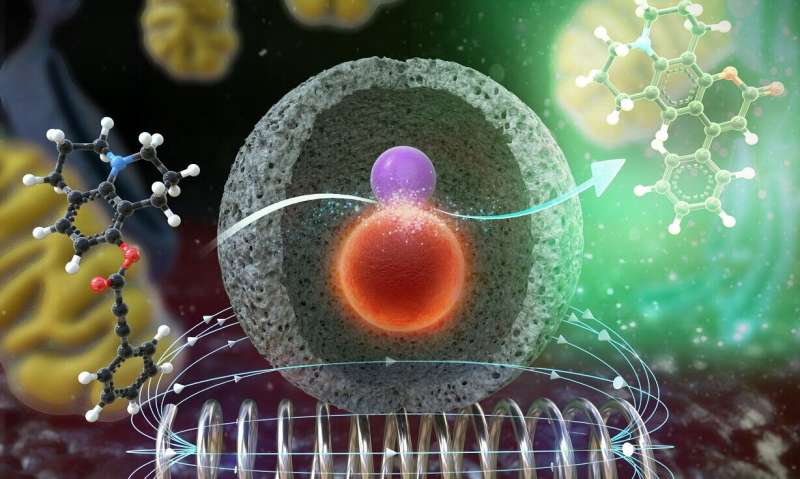Nanocatalysts that remotely control chemical reactions inside living cells

The enzymes responsible for catalytic reactions in our body's biological reactions are difficult to use for diagnosis or treatment as they react only to certain molecules or have low stability. Many researchers anticipate that if these issues are ameliorated or if artificial catalysts are developed to create a synergetic effect by meeting the enzymes in the body, there will be new ways to diagnose and treat diseases. In particular, if artificial catalysts that respond to external stimuli such as magnetic fields are developed, new treatment methods that remotely control bioreactions from outside the body can become a reality.
The research team led by Professor In Su Lee of the Department of Chemistry at POSTECH has developed a remote magnetic-sensitive artificial catalyst called MAG-NER, which shows high catalytic efficiency within living cells. The study was published as the supplementary cover paper for Nano Letters, an international journal on nanotechnology.
The research team mimicked the structure of vesicles, an organelle within a cell, and synthesized a magnetic-catalyst-combined nanoreactor with iron-oxide nanoparticles and palladium catalysts inside a hollow silica nanoshell.
When MAG-NER encounters an alternating magnetic field, iron-oxide nanoparticles inside cause magnetic field-induced heat and activate only the palladium catalyst without raising the exterior temperature. The research team succeeded in implementing the catalytic reaction with high efficiency, which transforms non-fluorescent reactants into fluorescent products through implanting MAG-NER into living cells then applying alternating magnetic fields. The research team also confirmed that the catalyst of MAG-NER can remain active for long periods of time without being contaminated by biomolecules in cells and does not affect the cells' survival.

Using MAG-NER, it is anticipated that diagnosis and treatment methods, that can artificially remote control the cell's functions, can be developed as artificial molecules can be synthesized or chemical reactions can be induced within cells using magnetic fields that are harmless to the body.
Professor In Su Lee who led the research explained, "This research is a result of utilizing the hallow nanoreactor materials that our lab has been developing over the years and is valued as an innovative chemical tool that will advance biomedical and biological research."
More information: Jihwan Lee et al, Magnetothermia-Induced Catalytic Hollow Nanoreactor for Bioorthogonal Organic Synthesis in Living Cells, Nano Letters (2020). DOI: 10.1021/acs.nanolett.0c01507
Journal information: Nano Letters
Provided by Pohang University of Science & Technology (POSTECH)




















